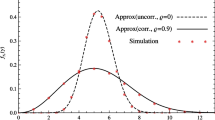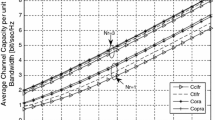Abstract
This paper provides a useful method for predicting the approximate performance of space time codes over quasi-static fading channels. Based on evaluating the signal-to-noise ratios (SNR) of the extrinsic information in the minimum mean-square error (MMSE) detector, we obtain upper and lower bounds on SNR, which are the convergent limits of the SNR evolution of the extrinsic information between the MMSE detector and the a posteriori probability decoder. Based on the SNR bounds the upper and lower bounds of frame-error-rate and bit-error-rate can be assessed by averaging over the fading coefficients. The results of numerical simulations are found to be in excellent agreement with the semi-analytic bounds.
Similar content being viewed by others
References
Tarokh V., Seshadri N., Calderbank A. R. (1998) Space–time codes for high data rate wireless communication: Performance criterion and code construction. IEEE Transactions on Information Theory 44: 744–765
Lin X., Blum R. (2000) Improved space–time codes for serial concatenation. IEEE Communications Letters 4: 221–223
Baro S., Bauch G., Hansmann A. (2000) Improved codes for space–time trellis-coded modulation. IEEE Communications Letters 4: 20–22
Wang N., Steven D. B. (2007) Approximate minimum BER power allocation for MIMO spatial multiplexing systems. IEEE Transactions on Communications 55: 180–187
Stefanov A., Duman T. M. (2003) Performance bounds for turbo-coded multiple antenna system. IEEE Journal of Selected Areas in Communications 21: 2134–2140
Bouzekri H., Miller S. L. (2003) An upper bound on turbo codes performance over quasi-static fading channels. IEEE Communications Letters 7: 374–381
Xiang N. Z., Ali G. (2006) Performance bounds for combined channel coding and space–time block coding with receive antenna selection. IEEE Transactions on Information Theory 55: 1441–1445
Ling C., Li K., Kot A. C. (2008) Performance of space–time codes: Gallager bounds and weight enumeration. IEEE Transactions on Information Theory 54: 3592–3610
Wu X., Xiang H., Ling C. (2007) New Gallager bounds in block-fading channels. IEEE Transactions on Information Theory 53: 684–694
Ling C., Wu X., Li K., Kot A. C. (2007) Gallager bounds for noncoherent decoders in fading channels. IEEE Transactions on Information Theory 53: 4605–4614
Divsalar D., Dolinar S., Pollara F. (2001) Iterative turbo decoder analysis based on density evolution. IEEE Journal of Selected Areas in Communication 19: 891–907
ten Brink S., Kramer G., Kramer G., Kramer G. (2004) Design of low-density parity-check codes for multi-antenna modulation and detection. IEEE Transactions on Communication 52: 670–678
Xiaodong W., Poor H. V. (1999) Iterative (turbo) soft interference cancellation and decoding for coded CDMA. IEEE Transactions on Communication 47: 1046–1061
Ben L., Xiaodong W. (2001) Iterative receivers for multiuser space–time coding systems. IEEE Journal of Selected Areas in Communication 18: 891–907
Poor H. V., Verdu S. (1997) Probability of error in MMSE detection. IEEE Transactions on Information Theory 43: 858–871
Proakis J. G. (1995) Digital communications. McGraw-Hill, New York
Author information
Authors and Affiliations
Corresponding author
Rights and permissions
About this article
Cite this article
Wu, YJ., Yu, Z. Predicting Approximate Performance Bounds for Space–Time Codes Over Quasi-Static Fading Channels. Wireless Pers Commun 70, 153–164 (2013). https://doi.org/10.1007/s11277-012-0685-4
Published:
Issue Date:
DOI: https://doi.org/10.1007/s11277-012-0685-4




